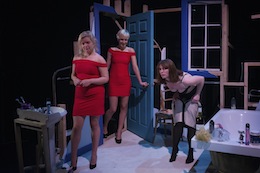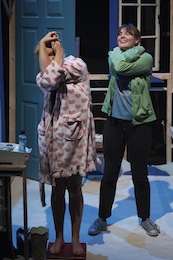“If you're going to tell people the truth,” George Bernard Shaw is alleged to have said, “you better make them laugh; otherwise they'll kill you.” These sentiments set the tone of Anam Theatre’s intuitive production of Clare McIntyre’s challenging and provocative Low Level Panic. The Galway-based theatre company anatomises this uncompromising text with a rattling urgency while celebrating the simmering comedy around which McIntyre wraps her feminist missile.
Low Level Panic charts the relationship between three female flatmates: Mary, Jo and Celia. In their frank exchanges about their self-perception, sexuality and identity, the play views their relationship through the lens of popular depictions of women and examines how each character is both moulded by and complicit in these portrayals. Premiered at London’s Royal Court Theatre in 1988, the late Clare McIntyre’s script is spiked with the unflinching candour of its dialogue and the demands of partial and full nudity it places on the actors.
 Australian director Justin Martin effectively shifts the production into a contemporary Irish setting and imaginatively interprets the text. Walking with her bike, Mary (Sarah O’Toole) is confronted by two men. Rather than convey the dialogue in a voiceover (as suggested in the script), Martin visualises the action with two men (Eoin Barton and Jerry Fitzgerald) slowly emerging from either side of the stage. As they move to attack Mary, Martin strangles the lights and Claire Healy’s unsettling cacophony of shrieking voices drowns Mary’s screams. Almost immediately, a series of white lights criss-cross the front of the set; the rising stage lights reveal a cluster of men, walking briskly past each other, staring at their Smartphones. It’s a powerful evocation of a victim’s sense of anonymity and helplessness in a sea of indifference.
Australian director Justin Martin effectively shifts the production into a contemporary Irish setting and imaginatively interprets the text. Walking with her bike, Mary (Sarah O’Toole) is confronted by two men. Rather than convey the dialogue in a voiceover (as suggested in the script), Martin visualises the action with two men (Eoin Barton and Jerry Fitzgerald) slowly emerging from either side of the stage. As they move to attack Mary, Martin strangles the lights and Claire Healy’s unsettling cacophony of shrieking voices drowns Mary’s screams. Almost immediately, a series of white lights criss-cross the front of the set; the rising stage lights reveal a cluster of men, walking briskly past each other, staring at their Smartphones. It’s a powerful evocation of a victim’s sense of anonymity and helplessness in a sea of indifference.
Martin crams the majority of the action into Peter Shine’s intentionally constrained bathroom set to heighten the production’s claustrophobia. To help explore how the internet has influenced pornography and blurred the lines between the private and public realms, the director incorporates a white projector screen above the set. When Mary, Jo (Eimear Kilmartin) and Celia (Aoife Martyn) attend a house party, the screen shows the Twitter conversation between the guests. Invoking recent social media furores that betrayed a virulent misogynistic strain, the thread includes real exchanges culled from the so-called ‘Slane Girl’ incident.
Yet Anam consciously undermines a simplistic depiction of women as victims of a distorting media. At the party, Mary, Jo and Celia use their phones to take photos of themselves striking raunchy poses that vividly resonate with the images in Jo’s Penthouse that Mary rails against; it subtly complicates the relationship between women and their representation, and underlines how women collaborate in their own portrayal.
As Jo, Eimear Kilmartin essays a particularly brave and affecting performance that veers from requiring her to stand naked in a bath, to sitting in the audience with a microphone and beer can delivering her lines in the style of a weary stand-up comedian, to quietly crying as she stares at a mirror while, on the projector screen, a recorded, uncharacteristically self-assured version of Jo articulates her sexual fantasies. Kilmartin leavens the emotional force of her portrayal by lacing it with broad physical comedy.
 Jo seems like the only link between Mary and Celia. In an empathetically observed depiction, Sarah O’Toole embodies the rampant tension between Mary’s desire to conform and her urge to be true to her convictions. (Jo wants Mary to “Forget who you are.”) O’Toole assiduously sculpts this conflict into her frenzied preparation for the party, as she zealously tries to crowbar herself into towering stilettoes, and the vigour with which she rips off the skin-coloured dress that makes her “feel like a tart”. Mary’s exchanges with Jo occasionally falter under their didactic strain, however, and this production would have benefited from softening this contrast.
Jo seems like the only link between Mary and Celia. In an empathetically observed depiction, Sarah O’Toole embodies the rampant tension between Mary’s desire to conform and her urge to be true to her convictions. (Jo wants Mary to “Forget who you are.”) O’Toole assiduously sculpts this conflict into her frenzied preparation for the party, as she zealously tries to crowbar herself into towering stilettoes, and the vigour with which she rips off the skin-coloured dress that makes her “feel like a tart”. Mary’s exchanges with Jo occasionally falter under their didactic strain, however, and this production would have benefited from softening this contrast.
Aoife Martyn’s Celia fervently counsels Jo “to make the most of yourself” and Martyn expressively invites us to witness the aching relief of Celia’s epiphany: finding the right moisturiser. The fittingly understated performance attests to Celia’s uncritical subscription to an archetypal female ideal. Martyn mines the comedy of her character’s focused, ritualistic placement of her five moisturiser bottles at the side of the bath and, in the panicked way she reacts to the car horn of her new boyfriend, emphasises how Celia is already manipulating herself to fit the grooves of her man.
A startling series of dream-like, freeze-frame sequences, where the characters move in a wordless symmetry, splatters this production’s canvas and lends it a cinematic quality. Anam is to be commended for this bold, courageous production that pokes its fingers – with a punkish derision – in the eyes of convention. Anam tells us some scathing truths and keeps us laughing.
Brendan Daly is a freelance arts journalist and critic for publications in Ireland and the U.S.